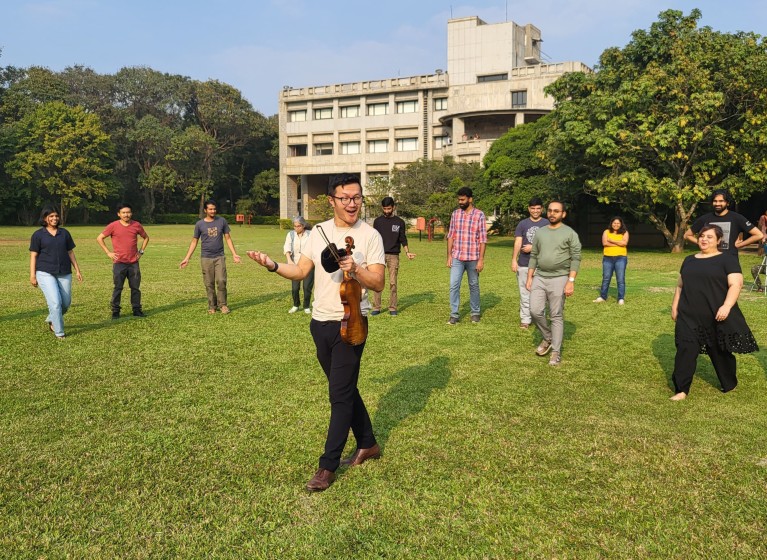
Neuroscience researcher Lewis Hou integrates Scottish dance and music ‘Ceilidih’ with science communication. Credit: NCBS Bangalore
Engagement with the arts has traditionally not been attractive enough for India’s scientists, who are mostly satisfied with publications and happily confined in the empirical boundaries of science. The unease within the scientific community about embracing arts often relegates the pursuit of creativity to a mere hobby or side interest.
This is a fundamental challenge hindering scientists’ ability to break free from established mould or undertake disruptive and interdisciplinary production of knowledge.
Collaborations between artists and scientists may not always produce tangible outcomes. However, such collaborations often spark insights, allowing both sides to reflect and enhance their practice and thinking. Artists can inject the much-needed creativity and questioning – prerequisites of scientific practice – to contextualise scientific information and its output.
Why the discomfort?
Scientists may be uncomfortable with the arts for a variety of reasons. In India, arts subjects are sometimes considered intellectually inferior to the sciences. A household example is the choice between science and arts streams for students in grade 11, with science often ranking higher on the social and intellectual scale.
Many find an overlap between the two disciplines incompatible. Due to their training (or lack thereof), scientists also lack the ability to engage in genuine dialogues and prefer lecturing when discussing scientific topics. Scientist's exposure to art and science collaborations is limited due to a lack of available avenues and funding, as well as the esoteric nature of these programmes.
The arts have, however, helped disrupt traditional ways of communicating science by making it more accessible, particularly to those who would not have had access otherwise, contributing to a more inclusive science culture.
For example, Lewis Hou, a neuroscience researcher turned science educator, demonstrated at the recent science festival, a seamless integration of the Scottish dance and music ‘Ceilidih’ in their science communication and engagement with young people and public audiences, particularly from the marginalised and underserved sections. Unlike India, where art-science experiments usually occur in elite, urban settings with exclusive audiences, Hou advocates democratising science through the arts. His approach rejects the confinement of science to high-achieving, predominantly affluent students in classrooms. Unfortunately, in India, folk and indigenous arts are often dismissed in academic settings.
Similarly, David Price and his organisation, Science Made Simple, UK, have used busking to promote science. Price uses the highly dynamic technique to engage children and adults in everyday science, and trains scientists to use it. Science busking uses DIY materials and happens in streets, cultural venues or city fairs. At one point, India’s people science movements also used arts and street theatre to promote science among rural audiences but the process was not documented or popularised well.
How the arts inform the sciences
Arts play a profound role in sharpening scientific inquiry and deciphering the world. Historic cases in point are Leonardo Da Vinci’s brilliant architectural and engineering designs, Santiago Ramón Y Cajal's detailed drawings of the neural network, or the 3-D models of the father-son glassmakers Leopold and Rudolf Blaschka, who greatly contributed to the understanding of marine life.
Art and science collaborations are increasingly being regarded as a strong pillar of knowledge production. Physicist Takashi Ikegami combines arts, philosophy, and science to investigate complex systems and artificial life. He sees this intersection as a powerful force, providing new avenues and tools for scientific and artistic exploration. Ikegami believes that such exploration is beyond human capability if studied solely through one disciplinary lens. Neuroscientist Alan Harvey, who spent much of his career studying the molecular details of spinal cord injury, returned to his passion for music to discover the science behind why music is so important to humans. These examples increasingly illustrate that scientists are employing artistic and philosophical tools to make sense of a complex world and find solutions that require unconventional approaches. In her book Art, Science, and the Politics of Knowledge, Hannah Star Rogers proposes breaking the long-standing divide between the two fields by using Science and Technology Studies (STS) to investigate art-science practices. This, she believes, would help build evidence for the overlapping approaches in art and science to produce knowledge.
Funders must support creative experiments
There are numerous examples of art and science collaborations in the Global North, where liberal arts education is prevalent and there are sufficient resources for creative experiments. Scientists in India need to be exposed to the arts and humanities early in their academic journey to be able to effectively engage in cross-disciplinary as well as public dialogues on science. They also need support for interdisciplinary experiments in their scientific practice. Stepping out of their comfort zones is critical for true scientific and societal breakthroughs.
Some Indian institutions, such as the Science Gallery Bengaluru, and public platforms, such as the India Science Festival, are providing fertile ground for these art and science collaborations, but more such endeavours are needed. Progressive funders must also recognize the need to invest in such projects to change how science is practiced, communicated, and supported in India.
